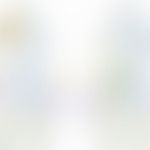Synonym(s)
DefinitionThis section has been translated automatically.
Interleukins (from Latin inter = between and Greek λευκός = white and κινεῖν = to move) are a group of endogenous, short-chain regulatory proteins (cytokines) of the immune system (interleukin-1 to interleukin-38). Interleukins are mediators for the induction, course and control of T-cell-mediated cytotoxic immune reactions and B-cell activation (antibody production).
Interleukin-12 is a pleiotropic, heterodimeric protein whose two covalent subunits p35 and p40 are encoded by two different genes. The gene for the subunit designated p35 is located on chromosome 3. The gene for the subunit p40 is located on chromosome 5. The p40 subunit contains a binding site for heparin. It is also a subunit of interleukin-23.
General informationThis section has been translated automatically.
The cytokine has a central function in the initiation and maintenance of a T helper cell-1 (TH-1)-accentuated immune response (cellular defense).
Interleukin-12 is mainly produced by B lymphocytes after induction, primarily by bacteria or bacterial components (e.g. LPS, toxins) or by parasites. To a lesser extent, interleukin-12 is also produced by activated T lymphocytes, monocytes and macrophages.
The interleukin-12 receptor is expressed on activated CD4+ and CD8+ T lymphocytes and on NK cells.
IL-12 is a ligand for a receptor consisting of two amino acid chains, IL-12Rβ1 and IL-12Rβ2. It is encoded by the IL12RB1 gene.
The interleukin-12 receptor is primarily expressed on B cells, as well as on activated CD4+ and CD8+ T lymphocytes and NK cells. The signals of the ligand-bound IL-12Rβ2 complex are transmitted via the JAK2 and TYK2 signaling pathways. Mutations in this gene lead to an immunodeficiency syndrome(immunodeficiency 30)
Interleukin-12 production is suppressed by cytokines such as type I interferons, interleukin-10 and TGF-beta as well as by prostaglandin E2 .
Interleukin-12 activates antigen-presenting cells such as dendritic cells, especially those with a CD1c+ phenotype, as well as monocytes, macrophages and neutrophil granulocytes.
Interleukin-12 stimulates proliferation and cytotoxicity of activated NK cells, CD8+ and CD4+ T cells; furthermore of monocytes, macrophages and neutrophil granulocytes. In TH2 helper cells, it suppresses the formation of interleukin-4, interleukin-5 and interleukin-10. Furthermore, interleukin-12 induces antiangiogenic cytokines (potential anti-tumor effect) and suppresses IgE production induced by interleukin-4. These effects are associated with IFN-γ production.
Interleukin-12 induces the production of other cytokines and acts as an endogenous pyrogen alongside interleukin-1 and TNF-α.
Interleukin-12 influences the course of infectious diseases. Some microorganisms such as Candida albicans are able to inhibit interleukin-12.
Alongside interferon-gamma (IFN-γ) and IL-18, interleukin-12 plays a key role in the development of Th1 cells. Thus, interleukin-12 influences a variety of immunological processes; its general pathophysiological role can be defined as a broad Th1-type immune response against pathogens in general. Its potential role as a cancer therapeutic is interesting; a large number of publications are available in this regard.
You might also be interested in
General therapyThis section has been translated automatically.
Psoriasis, spondyloarthritis (Spa) with axial as well as peripheral arthritis, ankylosing spondylitis, psoriatic arthritis (PsA): The term spondyloarthritis (Spa) refers to both axial and peripheral arthritis, including ankylosing spondylitis (AS) and psoriatic arthritis (PsA). They are closely associated with psoriasis. Genome-wide associated studies (GWAS) showed that these arthritides have "single nucleotide polymorphisms (SNPs)" of the IL-23R pathway, while HLA-B27 is not associated with all these diseases. Thus, the IL-23 pathway is the common genetic denominator. In experimental animal models, the IL-23/IL-17 axis has been shown to play a central role in SpA-related arthropathy, manifesting initially as enthesitis but also as synovitis and axial inflammation and as associated aortic root and as psoriasis. The known immunological changes in human enthesis argue for the presence of IL-23-producing myeloid cells, not only in enthesis, but also in other SpA-associated areas such as skin and intestine.Furthermore, drugs targeting the IL-23 pathway show excellent efficacy in psoriasis, in IBD, and also in peripheral arthropathy associated with SpA.
Ustekinumab is a human IgG antibody that binds to the common p40 protein subunit of unbound interleukin-12 and -23. The complex thus prevents docking to the common receptor interleukin -12R on the surface of naïve T cells.
Tumor diseases: Interleukin-12 exhibits diverse potent antitumor effects. It was obvious to use interleukin-12 as a therapeutic agent in various tumor diseases due to its broad immunological effects. The cytokine does not have a direct inhibitory effect on tumor growth. Rather, interleukin-12 is able to initiate a prominent Th1-type immune response to tumor tissue. Severe side effects with systemic application and a very narrow therapeutic window have significantly dampened the initial enthusiasm.
Kaposi sarcoma: In this angiosarcoma, the effects have yet to be conclusively evaluated.
Cutaneous T-cell lymphoma: The results of interleukin-12 therapy in cutaneous T-cell lymphoma have yet to be conclusively evaluated.
Note(s)This section has been translated automatically.
Psoriasis, spondyloarthritis (Spa) with axial as well as peripheral arthritis, ankylosing spondylitis, psoriatic arthritis (PsA): The term spondyloarthritis (spa) refers to both axial and peripheral arthritis, including ankylosing spondylitis (AS) and psoriatic arthritis (PsA). They are closely associated with psoriasis.
Genome-wide associated studies (GWAS) have shown that these arthritides have single nucleotide polymorphisms (SNPs) of the IL-23R signaling pathway, while HLA-B27 is not associated with all these diseases. The IL-23 signaling pathway is therefore the common genetic denominator.
In experimental animal models, the IL-23/IL-17 axis has been shown to play a central role in SpA-related arthropathy, which initially manifests as enthesitis, but also as synovitis and axial inflammation, as well as associated aortic root and psoriasis.
The known immunologic changes in human enthesis suggest the presence of IL-23-producing myeloid cells, not only in enthesis, but also in other SpA-associated areas such as skin and gut. Furthermore, drugs targeting the IL-23 signaling pathway show excellent efficacy in psoriasis, in IBD and also in peripheral arthropathy associated with SpA.
Tumor diseases: Interleukin-12 shows various potent antitumor effects. It was obvious to use interleukin-12 as a therapeutic agent for various tumor diseases due to its broad immunological effects. The cytokine does not have a direct inhibitory effect on tumor growth. Rather, interleukin-12 is able to initiate a marked Th1-type immune response to the tumor tissue. Severe side effects with systemic application and a very narrow therapeutic window have significantly dampened the original enthusiasm.
Kaposi's sarcoma: The effects of this angiosarcoma cannot yet be conclusively evaluated.
Cutaneous T-cell lymphoma: The results of interleukin-12 therapy in cutaneous T-cell lymphomas cannot yet be conclusively evaluated.
It is possible that interleukin-12 can activate repair enzymes that are able to repair damaged DNA.
LiteratureThis section has been translated automatically.
- Brunda MJ et al (1993) Antitumor and antimetastatic activity of interleukin 12 against murine tumors. J Exp Med178:1223-1230.
- Ferretti E et al (2010) Direct inhibition of human acute myeloid leukemia cell growth by IL-12, Immunol Lett 133:99-105.
- Golab J et al (2000) Direct stimulation of macrophages by IL-12 and IL-18-a bridge too far? Immunol Lett72:153-157.
- Hamza T et al (2010) Interleukin 12 a key immunoregulatory cytokine in infection applications. Int J Mol Sci 11:789-806.
- Hernandez-Alcoceba R et al (2016) Gene therapy approaches against cancer using in vivo and ex vivo gene transfer of interleukin-12. immunotherapy 8:179-198 .
- Johnsson HJ et al (2015) Interleukin-12 and interleukin-23 inhibition in psoriatic arthritis. Clin Exp Rheumatol 33(5 Suppl 93):S115-118.
- Judson MA et al (2011) Molecular profiling and gene expression analysis in cutaneous sarcoidosis: the role of interleukin-12, interleukin-23, and the T-helper 17 pathway. J Am Acad Dermatol 66:901-910
- Lasek W et al (2014) Interleukin 12: still a promising candidate for tumor immunotherapy? cancer immunol immunother 63:419-435.
- Méndez-Samperio P (2010) Role of interleukin-12 family cytokines in the cellular response to mycobacterial disease. Int J Infect Dis 14:e366-371.
- Ngiow SF et al (2013) A balance of interleukin-12 and -23 in cancer. Trends Immunol 34:548-555.
- Tang MM et al.(2013) Rapid downregulation of innate immune cells, interleukin-12 and interleukin-23 in generalized pustular psoriasis with infliximab in combination with acitretin. Dermatology 225:338-343.
- Tausend W et al (2014) Systematic review of interleukin-12, interleukin-17, and interleukin-23 pathway inhibitors for the treatment of moderate-to-severe chronic plaque psoriasis: ustekinumab, briakinumab, tildrakizumab, guselkumab, secukinumab, ixekizumab, and brodalumab. J Cutan Med Surg 18:156-169.
- Sun L et al (2015) Interleukin 12 (IL-12) family cytokines: Role in immune pathogenesis and treatment of CNS autoimmune disease. Cytokines 75:249-255.
- Vignali DA et al.(2012) IL-12 family cytokines: immunological playmakers. Nat Immunol 13:722-728.https://www.ncbi.nlm.nih.gov/pubmed/22814351
- Wesa AK et al.(2001) IL-1 beta induces dendritic cells to produce IL-12 Int Immunol. 13:1053-1061.
- Zundler S et al.(2015) Interleukin-12: Functional activities and implications for disease. Cytokine Growth Factor Rev 26:559-568. https://www.ncbi.nlm.nih.gov/pubmed/26182974





